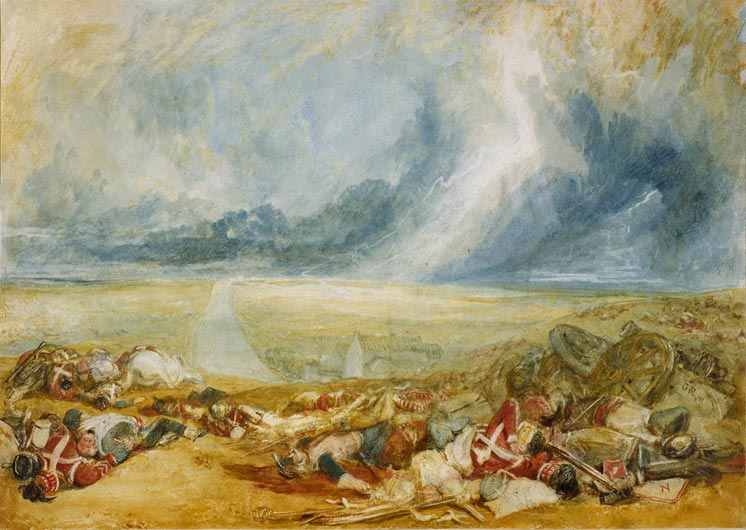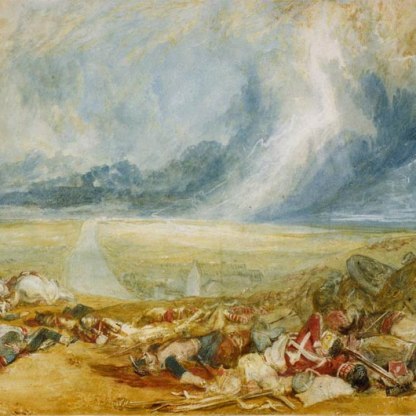The Field of Waterloo

And Harold stands upon this place of skulls,
The grave of France, the deadly Waterloo!
How in an hour the power which gave annuls
Its gifts, transferring fame as fleeting too!
Lord Byron, Childe Harold's Pilgrimage, Canto III, ll. 154–60, 1818
On the evening of 18 June 1815, twenty-three years of war in Europe came to an end. The French army of Napoleon Bonaparte was defeated by a combined force of British, Dutch, Belgian and Prussian troops, led by the duke of Wellington and the Prussian Field Marshal Gebhard Leberecht von Blücher. This decisive encounter took place in the fields around the small Belgian village of Waterloo.
The fall of Napoleon opened up continental Europe to British travellers for the first time since 1803. The English painter J.M.W. Turner took advantage of the new freedom of movement, and in August 1817 he began a tour of Belgium and Germany. On Saturday the 16th, he visited the field of Waterloo where he made several sketches that resulted in this small watercolour and a large oil painting, now in Tate Britain.
There was an understandable sense of national swagger in England after Wellington's hard-won victory. The painter Benjamin Robert Haydon wrote in his diary for 11 July 1815:
There is something to me infinitely imposing, sublime & overwhelming in the present degraded state of France & Napoleon Buonaparte. English troops in the Champs Elysées! What a change! What punishment for their presumption, what a glory and reward for our forebearances.
But in human terms, Waterloo was a disaster for all the armies that took part. Never before had there been greater carnage on European soil. More than 40,000 men died during nine hours of fighting over an area of only three square miles. One soldier in every four perished.
And it is the human cost of war that Turner chooses to highlight in this atmospheric watercolour. Though it falls within the category of history painting, there is no sense here that the painter is glorifying his country's victory. War is shown to be a leveller. One is left to reflect upon violence and loss rather than heroism and victory.
In the foreground the corpses of both French and Allied troops lie heaped on top of one another. Their uniforms are scarlet and blue, but the blood that flows from them is the same deep red. To the left a cannon has been overturned on which we can read 'G R III' – the monogram of George III, Britain's king at the time.
The buildings in the middle distance represent either La Haye Sainte or Hougoumont, two walled farms around which some of the fiercest fighting took place. In the distance, at the end of the road that cuts through the plain, we can just make out the buildings of a town or village – perhaps Waterloo itself.
But this architecture is overshadowed by the enormous storm raging in the sky, echoing the violence that has taken place below. As so often in Turner's art, the elements seem to belittle man and his work. In this scene, while the earth is flat and lifeless, the sky is a mass of movement and shades of colour. A flash of white lightning cuts through the heavy clouds on the left. Elsewhere, a great swirl of cloud mirrors the road heading off into the distance. There is something almost biblical about this tempest, and the crowd of dead in the foreground further adds to the sense of a Day of Wrath.
Subsequent to his trip to Waterloo, Turner travelled down the Rhine, sketching and painting the landscape. Examples from this journey, which were later bought by his patron and friend Walter Fawkes, are owned by the Fitzwilliam.
When Turner died in 1850 he bequeathed his works to the nation. These are now housed in Tate Britain. But the Fitzwilliam owns an important collection of his watercolours, half of which were left to the museum by John Ruskin, Turner's most passionate and articulate contemporary supporter. Given the delicate nature of watercolour, which is particularly prone to fading if exposed to light for any length of time, these works are rarely on public display.
Themes and periods
Data from our collections database
Walter Fawkes, Farnley Hall; Major Richard Fawkes; A.W. Fawkes
Acquisition and important dates
- Method of acquisition: Bequeathed
- Dates: 1942
Dating
- 1810s
- Production date: circa AD 1817 : watermark: J. Whatman / 1814
Maker(s)
- Turner, Joseph Mallord William Draughtsman
Materials used in production
Read more about this recordStories, Contexts and Themes
Other highlight objects you might like
Suggested Curating Cambridge products
Sign up to our emails
Be the first to hear about our news, exhibitions, events and more…






